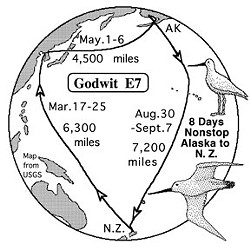[
{
"name": "Top Stories Video Pair",
"insertPoint": "7",
"component": "17087298",
"parentWrapperClass": "fdn-ads-inline-content-block",
"requiredCountToDisplay": "1"
}
]
In September of 2007 a one-pound Bar-tailed Godwit, designated E7, completed the longest non-stop flight ever recorded for a bird. This is her story.
E7 hatched in the tundra of western Alaska. She dined on insects and then, after fledging, on marine life near the mouth of the Yukon River, storing an immense amount of fat. At the age of less than four months, responding to a mysterious urge, she joined others on an incredible flight over the world's largest ocean.
To save weight, her stomach had atrophied before departure. She could not eat or drink for over a week, and probably saw no land on which to rest. With a brain the size of a peanut, her life depended upon her ability to navigate over featureless ocean day and night, without parental guidance. She did not understand how to do that, but her existence proved that it must be possible. Perhaps she kept track of the sun and moon when clouds permitted. Her retinas may contain a molecule named cryptochrome that may sense the Earth's magnetic field.
After flying three times the distance between San Francisco and New York without stopping, she eventually reached the shores of New Zealand with no fat to spare. Here she spent at least six months wading wetlands and beaches. In February 2007 she was captured by aliens who surgically implanted in her belly a battery-powered satellite-tracked radio transmitter.
A few weeks later, recuperated from the surgery, she flew 6,300 miles non-stop to the coast of China, replenished her fat reserves in five weeks and then flew 4,500 miles non-stop to Alaska. After four months there, raising a few chicks and refueling, she flew back to New Zealand, 7,200 miles in eight days, and into the record books. She may perform this incredible feat several times before succumbing to a predator or plunging exhausted into the ocean, all for the purpose of continuing her species. A Godwit completing this arduous journey 17 times would have traveled 300,000 miles.
Although Bar-tailed Godwits occasionally show up along our coast, similar looking Marbled Godwits are locally abundant. Their summer breeding grounds are in the northern prairies.
Speaking of Science
-

HSU Expanding Curriculum with Polytechnic Push
Jun 15, 2021 -

Davos Won't Save Us
Jan 23, 2020 -

The Need to Study Weed
Jan 16, 2020 - More »
more from the author
-
Nuclear Matters
- May 6, 2010
-
Sophie Smells a Shaker
- Feb 4, 2010
-
The Roots of Love
- Feb 5, 2009
- More »
































